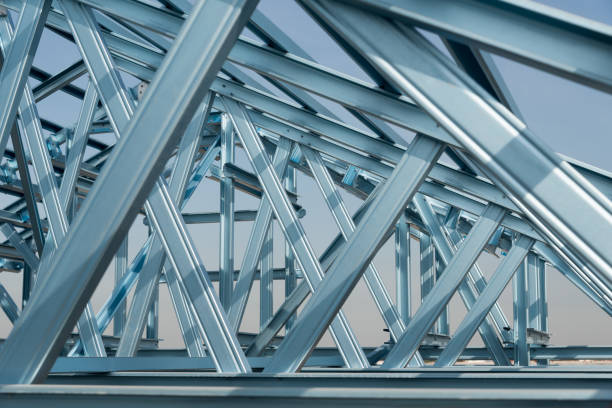In the realm of modern construction, steel structures have emerged as the epitome of strength, durability, and efficiency. Among the various components that contribute to their robustness, Purlin play a pivotal role. Often overshadowed by more prominent elements, purlins are the unsung heroes supporting the roofing system of steel buildings. These horizontal beams are integral in distributing loads and ensuring structural integrity. This article aims to explore the strategic use of Purlin in professional steel construction, shedding light on their significance as critical elements in the architectural and functional success of steel buildings.
Understanding Purlin
Purlins, in the context of steel construction, refer to horizontal beams that span between primary structural elements such as rafters, trusses, or portal frames. Their primary function is to provide support to the roof cladding and distribute the imposed loads, including dead loads (the weight of the roof itself) and live loads (such as snow, wind, or equipment loads). By efficiently transferring these loads to the primary structural elements, purlins contribute to the overall stability and strength of the building.
Types of Purlin
Purlincome in various forms, each designed to cater to specific structural requirements and building designs. The two primary types of Purlincommonly used in modern steel construction are:
Z Purlins: Z-shaped purlins are characterized by their distinctive shape, resembling the letter “Z” when viewed from the side. This configuration offers excellent strength-to-weight ratio, making them ideal for spanning long distances with minimal material usage. Z purlins are often used in industrial and commercial buildings where large roof spans are common.
C Purlins: C-shaped purlins, as the name suggests, have a profile that resembles the letter “C.” They are widely utilized in steel construction due to their versatility and ease of installation. C purlins are typically employed in smaller buildings or as secondary support members in larger structures.
Strategic Use of Purlin in Steel Construction
The strategic placement and utilization of Purlinare crucial considerations in the design and construction of steel buildings. Several factors influence their selection and deployment:
Structural Efficiency: Purlinare strategically positioned to optimize the structural efficiency of the building. By carefully analyzing the roof loads and span requirements, engineers determine the appropriate spacing and size of purlins to ensure adequate support while minimizing material usage and costs.
Load Distribution: Purlins play a critical role in distributing the various loads acting on the roof, including dead loads, live loads, and wind loads. Properly designed purlin systems evenly distribute these loads to prevent localized stresses and ensure the overall stability of the structure.
Compatibility with Roof Cladding: Purlinmust be compatible with the chosen roof cladding material and installation method. Whether it’s metal panels, corrugated sheets, or composite panels, the purlin system should provide a secure and stable base for attaching the cladding while accommodating thermal expansion and contraction.
Integration with Other Structural Elements: Purlins must seamlessly integrate with other structural elements such as rafters, trusses, and columns. Proper coordination during the design phase ensures that Purlincomplement the overall structural system and contribute to its integrity.
Benefits of Purlin in Steel Construction
The strategic use of Purlinoffers several benefits in modern steel construction:
Strength and Durability: Purlins, typically made from high-strength steel, provide robust support for the roof structure, enhancing the overall strength and durability of the building. Their resistance to corrosion and weathering ensures long-term performance and minimal maintenance requirements.
Speed of Erection: The lightweight nature of Purlinfacilitates swift and efficient installation, contributing to shorter construction timelines. This accelerated erection process translates to cost savings and faster occupancy of the building.
Design Flexibility: Purlin systems offer design flexibility, allowing architects and engineers to create innovative building designs with large roof spans and complex geometries. The versatility of Purlinenables the realization of architectural visions while maintaining structural integrity.
Cost Efficiency: By optimizing material usage and construction processes, purlin systems contribute to cost efficiency in steel construction projects. The reduced weight of steel components also translates to savings in transportation and handling costs.
Case Studies
To illustrate the practical application and benefits of Purlinin steel construction, let’s consider two case studies:
Industrial Warehouse: In the construction of a large industrial warehouse, Z purlins were used to span the vast roof area efficiently. The lightweight yet robust nature of the purlins enabled rapid installation, allowing the project to meet tight deadlines. The compatibility of the purlin system with the chosen metal cladding ensured a secure and weather-resistant roofing solution, essential for protecting the warehouse contents.
Retail Complex: A retail complex featuring diverse architectural elements required a flexible purlin system to accommodate varying roof spans and configurations. C purlins were employed as secondary support members in conjunction with primary structural elements, providing the necessary stability while enabling the realization of the architect’s vision. The speed of erection facilitated by the purlin system allowed the retail complex to open its doors to customers ahead of schedule, enhancing its competitive edge in the market.
Conclusion
In modern construction, steel structures stand as ideals of strength, durability, and efficiency. Purlin parts, though often overlooked, play a crucial role in supporting the roofing system and ensuring the structural integrity of steel buildings. By strategically selecting and deploying purlin systems, architects and engineers can optimize structural efficiency, enhance design flexibility, and realize cost savings. As unsung heroes of steel construction, Purlinexemplify the symbiotic relationship between form and function, contributing to the architectural and functional success of modern buildings.







